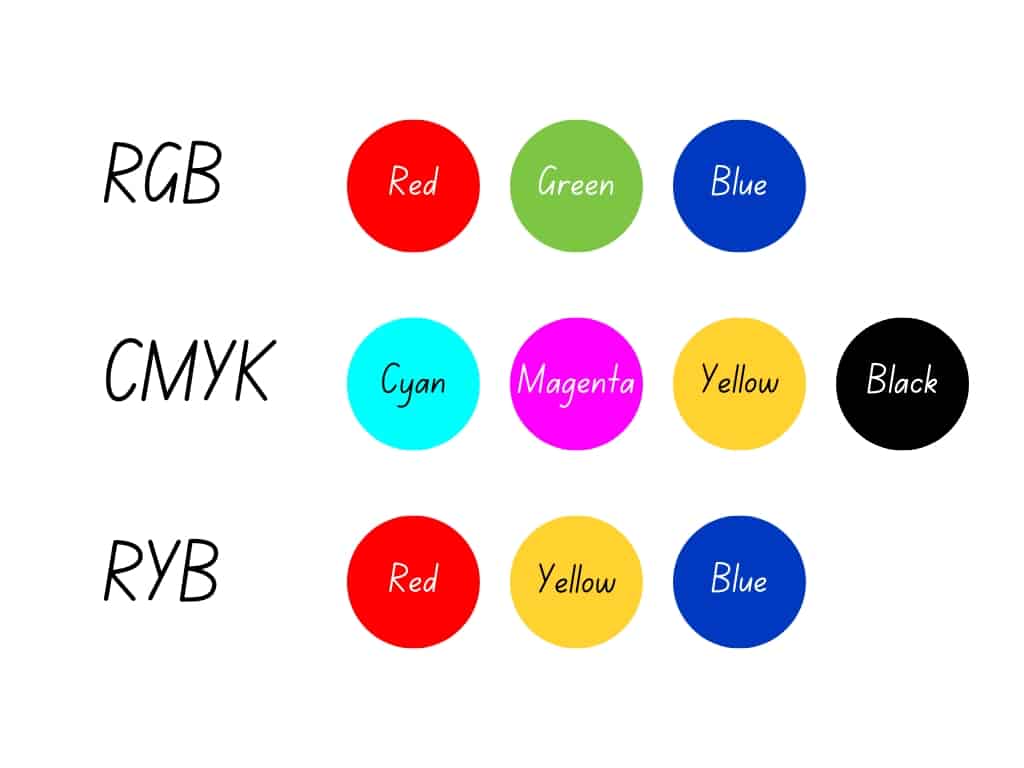What are the primary colors? The short answer is that it depends on the color model or color system you’re using. Here is the most comprehensive definition of these colors.
However, the correct answer is more complicated than that. Thus, because there are two color theories, there is a lot of confusion about primary colors.
The first is the additive color system, used for “material colors” by painters. The second is the subtractive color system, which is dedicated to physics and light and is used for colored light.
To better understand the real truth behind primary colors, we will answer the following questions: What is a primary color? Why are they referred to as basic colors? How many primary colors are there?
Today’s article will discuss the primary colors in each color model, why additive and subtractive colors are important, and some common misconceptions about primary colors.
So let’s get started with the definition, characteristics, and examples of primary colors. We’ll also talk about how they’re used in different fields like art, design, and printing. Let’s define primary colors!
Color Theory
The primary colors are the foundation of all colors. So, before learning about colors, you should first understand what primary colors are.
Today, you’ll learn about the primary colors in each color space and the additive and subtractive color systems.
Also, you can create secondary colors by mixing two of the primaries. Then you can make tertiary colors by combining a primary and a secondary color. This definition only applies to digital. In painting, tertiary colors are created by combining two secondary colors.
Primary Colors
The primary colors are the parents of all colors, also known as the building blocks!
They are referred to as foundation colors because they are used to create all other colors. Furthermore, because they are primary, they are displayed at equal intervals on the color wheel.
You’ve probably heard that the primary colors are red, yellow, and blue. That is correct, but it only applies to the RYB color model, which is designed for mixing paint colors.
The RYB color model, also known as the subtractive color model, is widely used in traditional art and painting.
There are, however, other color models, such as the RGB and CMYK models, in which the primaries differ.
The RGB color model is concerned with light colors on screen displays, whereas the CMYK color model is concerned with printing ink and pigments.
While the RGB color model is concerned with additively overlapping colors of light, the CMYK color model is concerned with subtractively mixing ink.
Primary Color Examples
Let’s take a closer look at some primary color examples.
Each color model is named after an acronym of the primary colors that are used. Isn’t it easy to remember?
As previously stated, the primaries differ from one color model to the next. In any case, they all serve as the foundation for creating other colors.
Here is a list of the primary colors in each color model:
What Are the Primary Colors of Paint (the RYB Model)?
- Red
- Yellow
- Blue
RYB is the traditional color model used in painting, and its primary colors are red, yellow, and blue. Furthermore, this is probably the oldest color model, as well as the most accessible.
The RYB color model has been used by artists and designers for centuries.
These colors were chosen because they were thought to be the three fundamental colors from which all other colors could be made.
This concept dates back to the 17th century when Franciscus Aguilonius (mathematician and physicist) argued against Aristotle’s binary color system (blue and yellow). As a result, he devised a color scheme based on three primary colors (Hyman). He specifically added red to Aristotle’s binary color theory. [1]
Over time, this concept gained widespread acceptance in the art world.
It is still widely used in many traditional art forms, such as oil or watercolor painting.
However, although red, yellow, and blue (RYB) are commonly taught as the primary colors, the CMY color model produces a wider range of color mixtures in practice.
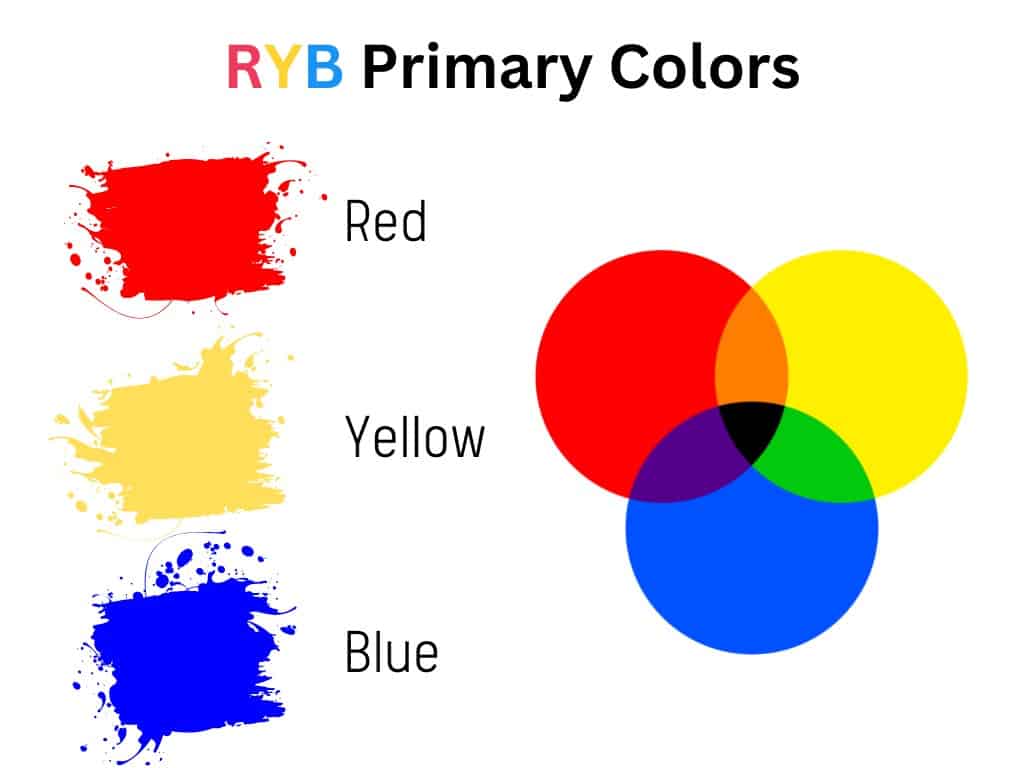
What Are the Primary Colors of Light (the RGB Model)?
- Red
- Green
- Blue
The primary colors inthe RGB color model are based on the three types of color receptors in the human eye, known as cone cells. There are three types of cone cells: red-sensing cones (60%), green-sensing cones (30%), and blue-sensing cones (10%). [2]
Cone cells detect different wavelengths of light and send signals to the brain, which are interpreted as different colors.
You might think that because we only have three types of cones labeled by the color at which they are sensitive, other colors are not possible. Guess what? Because of the overlapping of the cones and the brain’s ability to integrate the signals sent from them, we can see millions of colors. [3]
Thus, the RGB model uses red, green, and blue light to stimulate the three types of cone cells in the human eye, allowing them to produce the full range of colors that we can see.
That explains why the primary colors of light (the RGB color system) are red, green, and blue. Moreover, this is the order:
- 1st primary of light: red
- 2nd primary of light: green
- 3rd primary of light: blue
The order was determined by their wavelengths and the different types of human eye cones that are sensitive to different wavelengths of light:
- L cones: most sensitive to long wavelengths (red light)
- M cones: most sensitive to medium wavelengths (green light)
- S cones: most sensitive to short wavelengths (blue light)
In addition, the RGB color model can produce millions of different colors by varying the intensity of red, green, and blue light, making it an essential component of modern digital displays and technology.
As a result, the RGB model is the most widely used in modern color science.
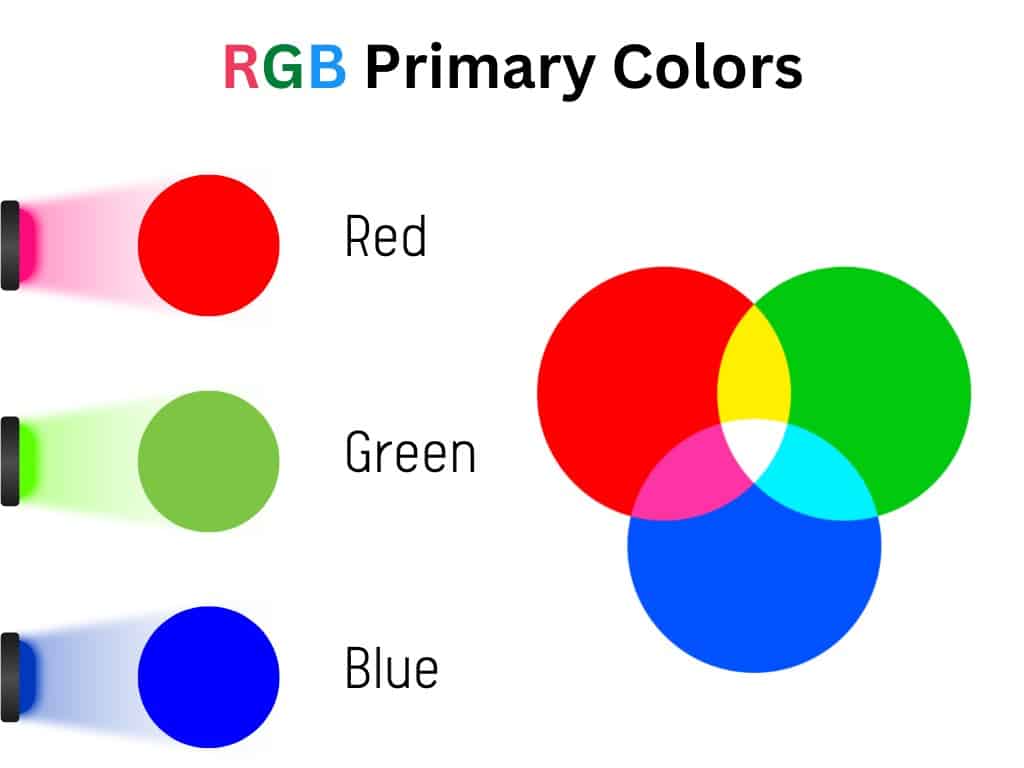
What Are the Primary Colors of Pigment (in the CMYK Model)?
- Cyan
- Magenta
- Yellow
The primary colors of the CMYK color model are cyan, magenta, yellow, and black. This model is used in the printing industry.
The CMYK color model is subtractive. Colors are produced by subtracting light as it passes through ink or pigments. In addition, colorants absorb and selectively transmit or reflect light in subtractive color mixing.
Furthermore, black is added as a fourth color to the CMYK model to provide greater control over the tones and shadows in a printed image.
The use of black also helps to conserve ink because it can be more efficient to use black ink instead of attempting to create dark tones by layering cyan, magenta, and yellow.
In practice, these are regarded as the optimal primary colors in terms of subtractive color mixing. When compared to RYB’s primary colors, they can produce a wider range of color mixtures.
You now understand how colors are created in both traditional painting and digital design, having acquired knowledge of the basic colors of each color system.
We can proceed now that you know what the primary colors are. The color differences between the models are caused by the differences in additive and subtractive color mixing.
As a result, each color model can be additive or subtractive. This is what is known as a color mixing system.
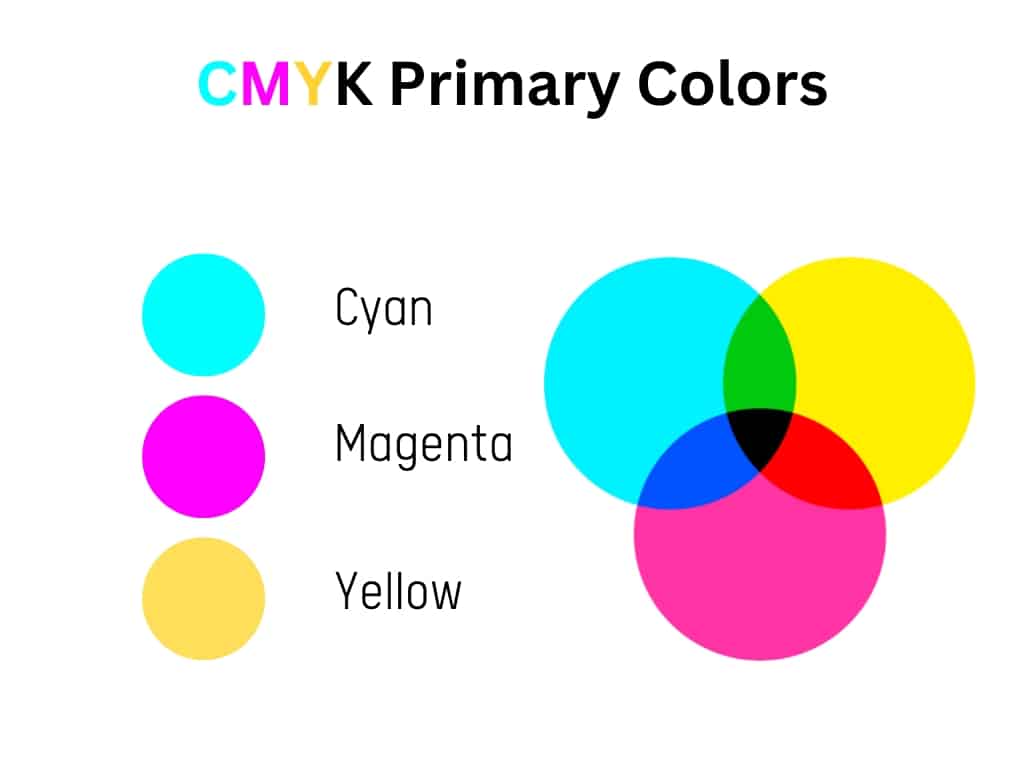
Additive and Subtractive Colors
There are primary colors that are additive and primary colors that are subtractive, in case you were wondering why primary colors differ between color models.
The reason for the confusion and contradictions is that there are two color theories:
The additive color theory is applied to “material colors” such as paints and pigments. This is used in traditional art.
The subtractive color theory is devoted to colored light. This is used in digital technology, such as computer monitors and digital displays.
Additive Color
Digital displays (smartphones, televisions, and computer screens) use light to display color by combining red, green, and blue (RGB).
According to Richard Raiselis (Professor of Art at the School of Visual Arts, Boston University), additive colors are those that produce more light when combined.
To better understand, project three circles of light on a wall using three flashlights. When you intersect the projection of two circles, you will notice that the color is brighter than the individual circle.
We add lightness with each mix (intersection of two or more lights). As a result, this is also known as additive light.
Now imagine that instead of using white flashlights, you use red, green, and blue flashlights. The intersection of the blue and red circle projections yields magenta. This is how the additive colors (red, green, and blue from the RGB color system) work.
So, additive color mixing happens when two or more colors generated by light waves merge before reaching the eye.
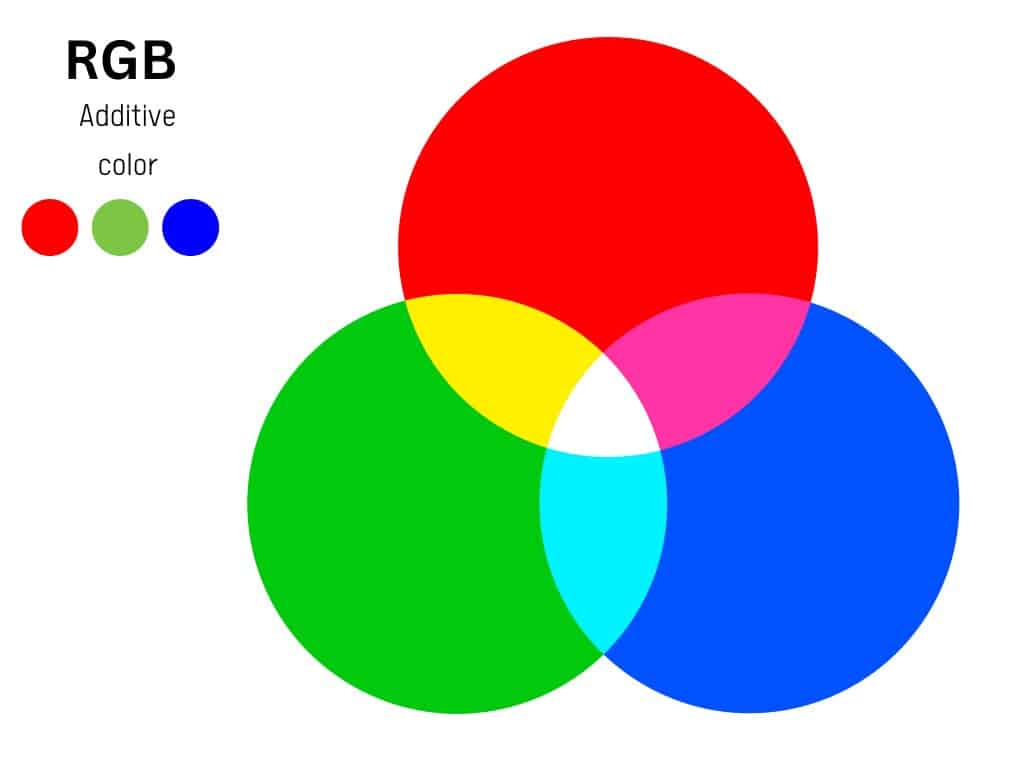
Moreover, combining all colors of the color spectrum results in white light, which your eyes perceive as the color white.
This fact was discovered by Isaac Newton through his prism experiments, which demonstrated that white light is made up of all the colors of the spectrum.
Furthermore, Newton demonstrated that after separating the colors through a prism, they can be recombined to form white light.
As a result, the RGB color model is an additive color system. To be more specific, the RGB model employs additive colors.
So, if you combine equal amounts of red and green light beams, you will get yellow, a secondary color in the RGB color space.
Thus, overlapping additive colors (red, green, and blue) in the RGB color model result in subtractive colors (cyan, magenta, and yellow).
Subtractive Color
Subtractive color refers to the color theory that deals with “material colors” such as paints, inks, or dyes, as opposed to additive color theory, which is used for screens and is based on objects that emit light.
When subtractive colors are used, the paints or inks absorb light and selectively transmit or reflect it. So, pigments, dyes, or inks reflect light to produce a specific color.
Starting with a white surface, the subtractive color model subtracts specific light (or light wavelengths) to produce the desired color. Paints, inks, and dyes all subtract color. They don’t even add color! So, when you mix paints or inks, subtractive color mixing occurs.
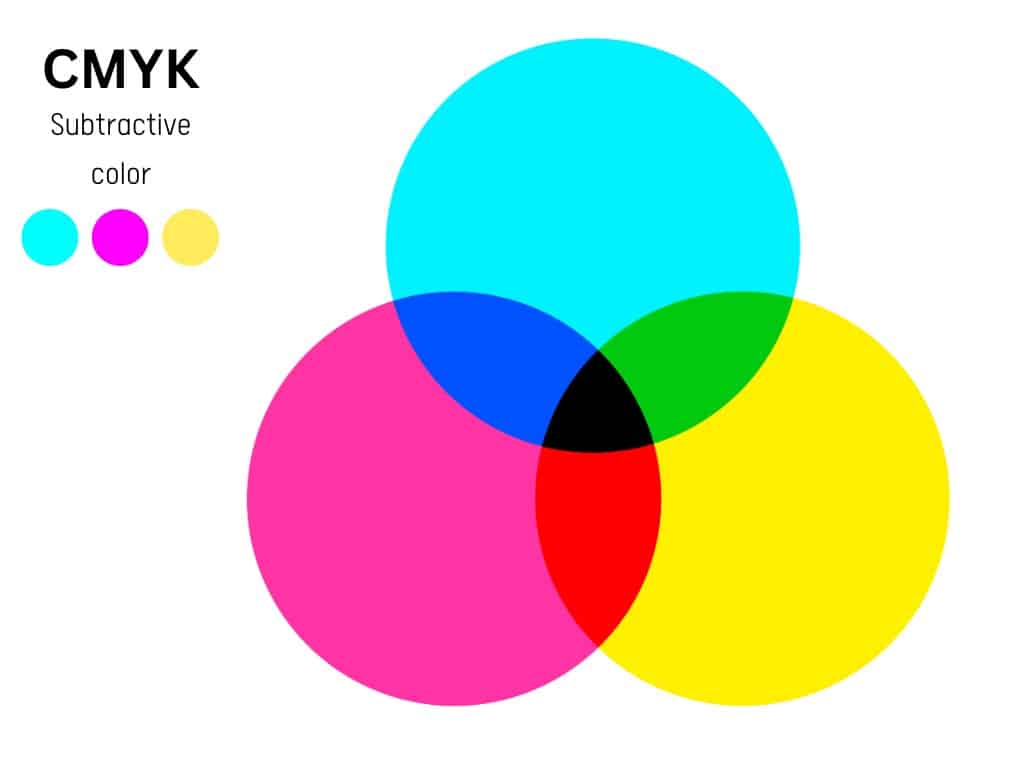
The subtractive colors are easily explained by using a white piece of paper on which all of the light wavelengths are reflected. Let’s paint some yellow on it. Yellow absorbs blue and violet light while allowing the other to pass through.
Then, add some blue paint to it. Blue absorbs light in the yellow, orange, and red spectrums. The color light that was not absorbed by either pigment will be green as a result.
With that out of the way, what are the subtractive colors? Or the subtractive color systems?
The subtractive color systems are RYB and CMYK, and each has its own subtractive primaries:
- RYB: red, yellow, blue
- CMYK: cyan, magenta, yellow
Hint: Many people believe that red is equivalent to magenta and blue is equivalent to cyan. This is wrong!
It’s worth noting that the CMYK color model corresponds to the additive colors of red, green, and blue (of the RGB color system):
- The color cyan absorbs red light (or wavelengths)
- Magenta absorbs green light
- Yellow absorbs blue light
So, subtractive colors (cyan, magenta, yellow) in the CMYK color system result from overlapping additive colors (red, green, and blue) in the RGB color model.
In conclusion, even though red, green, and yellow (the RYB color model) are the most commonly taught additive primaries, the CMYK color model can produce a wider range of color mixtures.
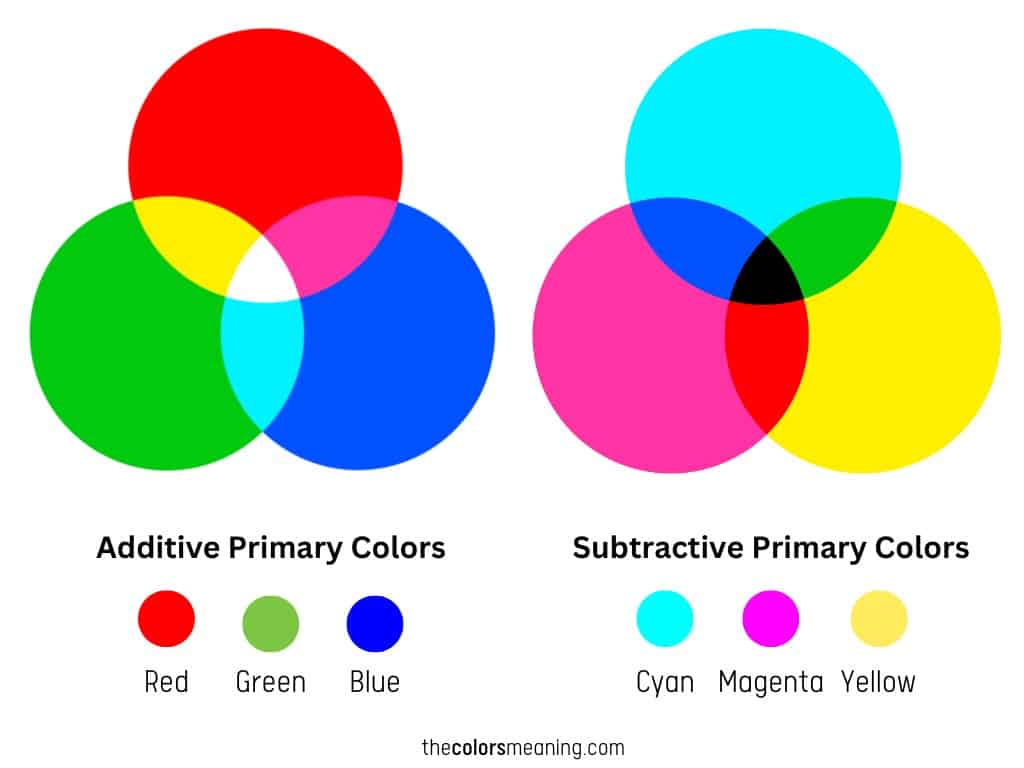
Primary Colors Are Not Pure
If you graduated from an art or design school, you were likely taught that primary colors are pure and cannot be created by combining other hues. That is incorrect! What’s even stranger is that it’s still being taught.
In practice, the primary colors of the RYB color model can be created by mixing the primary colors of the CMYK color model, and vice versa.
Don’t you think? Check it out:
- Green can be created by mixing yellow and cyan.
- Blue can be created by combining magenta and cyan.
- Cyan can be created by blending blue and green.
- Magenta can be created by mixing red and blue.
Thus, there are no “pure” primary colors that you can’t make by mixing other colors.
How Many Primary Colors Are There?
Regardless of the color model used, there are only three primary colors.
Thus, the primary colors in the RGB color model used in lighting are red, green, and blue, whereas the primary colors in the RYB color model used in traditional art are red, yellow, and blue.
The primary colors in CMYK, which is used in printing, are cyan, magenta, and yellow.
What Are the Additive Colors?
The primary additive colors are red, green, and blue, also known as RGB. Additive colors begin with black (lack of light) and end with white light; as color is added, the result is brighter.
What Are the Subtractive Colors?
The primary subtractive colors are cyan, magenta, and yellow, also known as CMYK. Subtractive colors begin with white (paper) and end with black; as color is added, the result is darker.
Is Red a Primary Color?
Red is a primary color in the RYB color system. In the CMYK system, red is a secondary color formed by mixing yellow and magenta.
Is Yellow a Primary Color?
Yellow is a primary color in both the RYB and CMYK color models. However, in the RGB color system, designed for physics and light, yellow is a secondary color made by mixing red light with green light.
Is Green a Primary Color?
Green is a primary color in the RGB color space. In the RYB and CMYK color spaces, green is a secondary color that can be made by mixing blue and yellow (RYB) or cyan and yellow (CMYK).
Is Blue a Primary Color?
Blue is a primary color in both the RGB and RYB color models. In the CMYK color model, blue is a secondary color that can be made by mixing cyan and magenta.
Is Cyan a Primary Color?
Cyan is a primary color in the CMYK color model used in the printing industry. However, in the RGB color space, cyan is a secondary color, resulting from mixing blue light with green light.
Is Magenta a Primary Color?
Magenta is a primary color in the CMYK color model, which is used in printing and works with inks. Magenta is a secondary color in the RGB color model, created by mixing green and blue light.
What Are the Three Primary Colors?
Primary colors vary depending on the color model. In the additive color model for light, red, green, and blue (RGB) are primary colors. In the subtractive color model for pigments, cyan, magenta, and yellow (CMY) are primary colors. Mixing these colors creates other colors.
Did you like this article on primary colors? Then please help us get the word out. Share it with your friends or save it to your Pinterest board.

